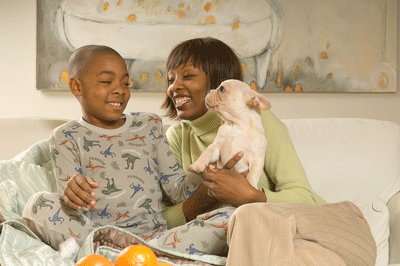This article is part of the #STCPreventionMatters campaign from the R Adams Cowley Shock Trauma Center, University of Maryland. For more information about the campaign and the Center for Injury Prevention and Policy, visit www.umm.edu/PreventionMatters
Dogs are one of the most popular pets in the United States and they are the top choice of pets among children. In 2001, an estimated 68 million homes had a dog. Between 30-40 percent of households in the U.S., Australia, and the U.K. own a dog.
Owning a dog can have many benefits. For children, it can help teach responsibility and encourage social development. For families, dogs can help provide a sense of security and companionship. Even more, service dogs help countless people with physical and emotional disabilities.
However, an estimated 4.7 million people in the U.S. are bitten by dogs every year. About 800,000 of them need medical treatment, and roughly 2,000 have to stay in a hospital overnight. Roughly 15 people every year are killed by dog bites. Bites most commonly affect the arm/hand (45.3 percent), leg/foot (25.8 percent), and head/neck (22.8 percent).
Even worse, over half of all people who are seriously injured are children between five and nine years old. Children are also the most likely to die following a dog-bite than any other age group.
Each year, these injuries result in $51 million in healthcare costs, and over $500 million in homeowner’s insurance claims.
What can we do to prevent these injuries?
The CDC recommends three ways to decrease the risk of dog bites:
•Owner and community education
•Animal control at the community level
•Dog bite reporting
For those interested in owning a dog, here are a few helpful tips:
•Ask a vet for advice before bringing a dog into the home
•Do not bring dogs with a history of aggression into a home with children
•Get to know the dog before you buy it
•If the child(ren) seem afraid of the dog, consider waiting a few months
before you buy it
•Spay/ neuter the dog (this will make it less aggressive and unable to have
babies)
•Do not “rough house” or wrestle with the dog
Like any animal, dogs will show certain warning signs when they feel like someone or something is going to hurt them.
Signs that should alert, that the dog maybe more likely to bite include:
•Growling
•Bearing its teeth
•Hair standing on end
•Laid back ears
•Lowered head
•Rigid posture on all fours
Children should be taught not to
approach an unfamiliar dog, and if threatened by one, not to make direct eye contact. Do not run and scream;
instead stand still “like a tree.” If attacked, they should curl into a ball, and lay “still as a log.”
In our experience at Shock Trauma, the worst injuries happen when an owner tries to break up a dogfight. No one should ever use their own body to break up a dog fight. Cases have
resulted in near amputation, disfigurement and even death. In one situation, a woman’s forearm bone was completely removed by the powerful grip of the dog bite, and both of her forearms and one of her hands became nearly useless.
Dogs that are in a heated battle will
attack whatever is in front of them. Trying to use your hands to grab the collar or the dog’s head or neck will only lead to a severe bite. Instead, stay clear! If you witness a serious dogfight, many vets recommend distracting the dogs with a loud noise, throwing cold water or spraying the dogs if a hose is available, or possibly throwing a blanket over the dogs. People should realize that placing themselves in between fighting dogs will almost always result in serious bodily harm.
When a dog bite occurs:
•Get information on the dog’s immunization status and ask for its records from the owner
•Seek medical attention immediately
•Notify animal control. In some states, the law requires reporting any dog bite that requires medical attention.
Raymond Pensy, MD, is an Associate Professor of Orthopaedics at the University of Maryland School of Medicine and an Orthopaedic Surgeon with the Division of Orthopaedic Traumatology at the R Adams Cowley Shock Trauma Center at the University of Maryland Medical Center. He specializes in hand and reconstructive microsurgery and a substantial portion of his practice is committed to limb salvage.
